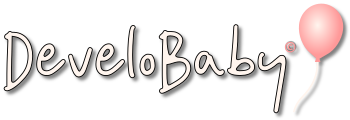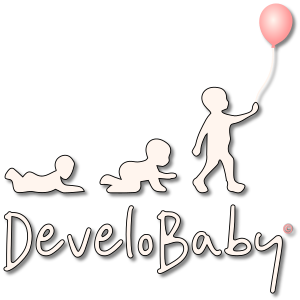Caring intentions!
On this page, I have collected baby milestones, i.e. the most important motor development milestones that a baby should pass during their first year of life. For each month, there are activities you can do with your child and examples of little signs to look out for.
I’m aware that writing about what a baby should be able to do by a certain age, can potentially cause concern for parents. It’s such a delicate balance: on the one hand, I do not want to cause unfounded concern. But on the other hand, I think that it is important to share this knowledge so that you, as a parent, are able to recognize the signs and react in good time.
It’s rarely necessary to worry if you notice that your child is not following the average curve to the letter. It is often enough to focus more on physical activity in everyday life and minimize passive positions, such as in baby carriers and car seats. However, if you notice that your child is significantly delayed in their development or is generally struggling to follow good quality movement patterns, then timely intervention is important. To that end, parental awareness, perhaps even a little parental concern, is an important factor in getting the right support and guidance for your child in a timely manner.
On this page, you’ll find a number of ways to get help right away. You can make an appointment to see me in the clinic or online or you can purchase my exercise programs from the webshop. For more individual or long term support contact your local health care providers!
Average Motor Development
When reading my milestones, it’s important to know that there is something called a normal distribution curve. This means that the milestones for each month are an average. Of course, some children may develop a little faster, while others may develop a little slower, without this necessarily being a problem for further motor development. However, if your child is so far behind that he or she falls outside the normal distribution, it is a professionally recognized standard to intervene with qualified physical therapy.
You should be more concerned about the quality of your child’s movements and whether your child is making progress than whether your child is within the average. If your child’s development is a little slower than average, but the quality is good, there is nothing to worry about.
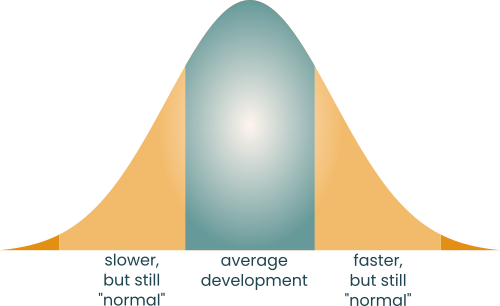
On the other hand, if your child is skipping milestones, developing asymmetrically, or disliking certain movement patterns and is progressing slower than average through the milestones, it would be of great benefit to catch this and intervene early. When we do, we can often help the child get back on track with their motor development so that they can continue to develop strongly and well throughout their childhood. Motor development is essentially nothing more than strength training. That’s why manual therapy can’t be the only answer. Exercise should always be done if you want to strengthen a person’s muscles – for both adults and children!
Baby milestones – month 1
In their first month, your baby
- Is still uncoordinated in their movements. With each passing week, you’ll notice that the movements become less jerky and more coordinated and smooth.
- Cannot hold their head when you hold them.
- Can lie on their tummy for a short time and briefly lift their head slightly.
- Might easily activate their Moro reflex stiffly stretching their arms in the air when something startles them in the slightest.
- Has a strong sucking reflex.
- Has strong grasping reflexes in hands and feet.
- Brings their hands briefly to their face.
- Sees about 20-30 cm and focus briefly on your face.
- Prefers black and white patterns or blocks.
- Has full neck mobility and doesn’t tilt their head to one side.
- Touches their nose with their toes while lying on their back.
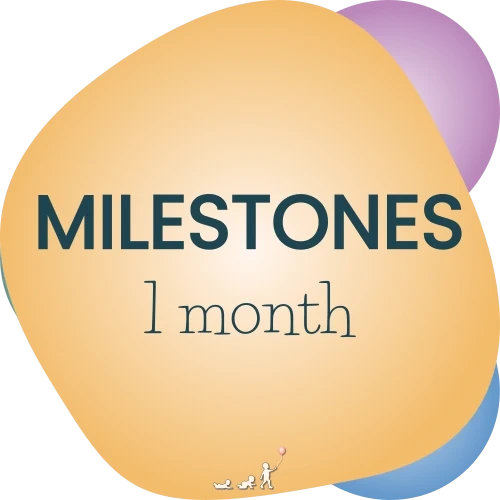
Inspiration for activities in month 1
- Skin-to-skin. Spend as much time as possible touching your baby or with your baby lying on top of you to calibrate your nervous systems. Mom needs to heal too, both physically and emotionally, after giving birth.
- Talk to your baby and look into their eyes.
Let your baby lie on their tummy every day (tummy time!). Place your baby on your chest or on the sofa. Use a wedged bed to lie on at first to make this easier for your baby. - You can make a small “rule” that your baby is on their tummy for a few seconds every time you change their diaper.
Consult your healthcare provider if your baby in month 1
- Feels stiff in the body and is difficult to bend.
- Seems overly fatigued.
- Does not feed or feeds with unusual difficulty.
- Tilts their head mostly to one side.
- Has a deformed or long skull that cannot be explained by pressure in the womb or during birth (e.g due to suction cup).
- Does not have primitive reflexes, such as the grasp reflex.
- Does not blink in bright light conditions.
- Does not get startled by loud noises.
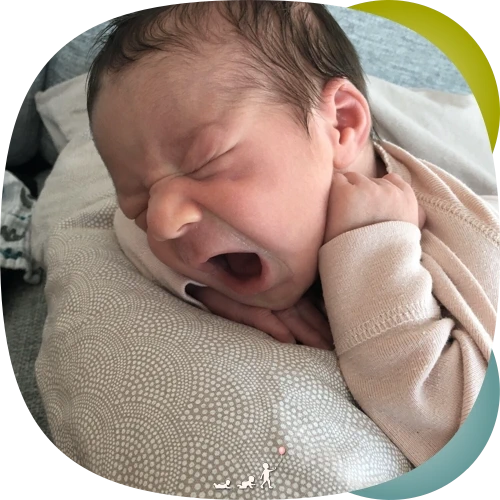
Baby milestones in month 2
In month 2, your baby
- Makes eye contact and smiles.
- Might start to babble a little.
- Begins to hold their head a little better during tummy time (about 45 degrees from their body).
- Sucks on their fingers.
- Taps a colorful toy briefly.
- Can move their neck freely to both sides (chin over shoulder).
- Looks at objects about 50 cm away.
- Expresses different needs with different types of cries.
- Turns their head to follow sounds.
- Responds to familiar voices (mommy and daddy).
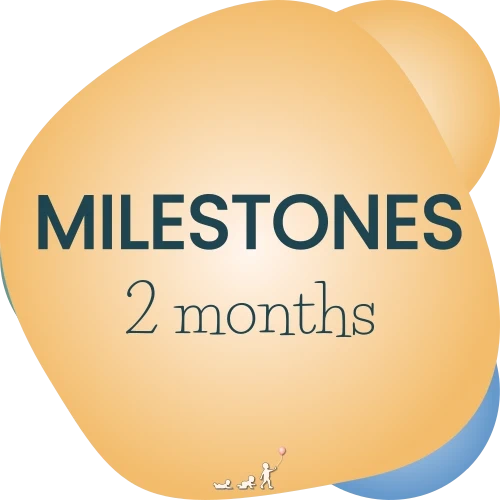
Inspiration for activities in month 2
- Many short passes of tummy time. Tip: Hold your baby gently on their bottom or make sure their body is slightly lying uphill – that makes it easier for your baby to hold their head!
- Practice eye contact.
- Practice skin-to-skin as much as possible.
Consult your healthcare provider if your baby in month 2
- Cries a lot or has a very high-pitched cry.
- Seems to be in pain.
- Doesn’t want to lie on their tummy.
- Seems overly fatigued.
- Arches their body backwards or bends their body in a C/banana shape consistently to either side.
- Lies consistently with head to same side when sleeping.
- Has a beginning flat or asymmetrical back of the head.
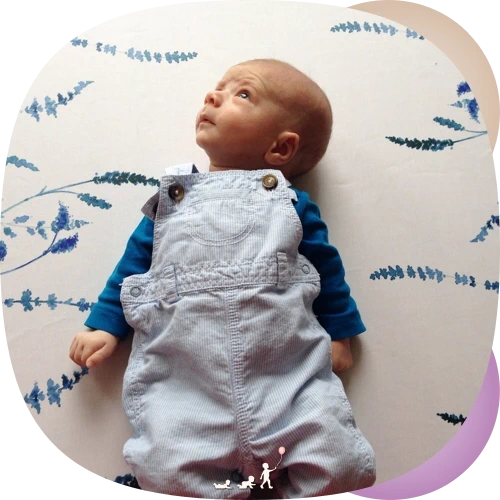
Baby milestones in month 3
In month 3, your baby
- Follows an object with their eyes in a gliding motion and both eyes in sync.
- Should be able to rotate their head 180 degrees from side to side while lying on their back.
- Uses smiles and babbling to make and maintain eye contact.
- Laughs and uses facial expressions.
- Grasps toys a little unsteadily, and may still need a little help to get a good grip.
- Puts toys in their mouth.
- Holds their head while held on your arm.
- Lies on their tummy, push their chest up supporting themselves on their forearms and lift their head 90 degrees facing forward.
- Opens their hands to extend heir fingers.
- Brings their hands to their mouth.
- Lifts their legs while lying on their back.
- Rotates their head to look in the direction of sounds such as rattling toys.
- Glances at an object without getting cross-eyed.
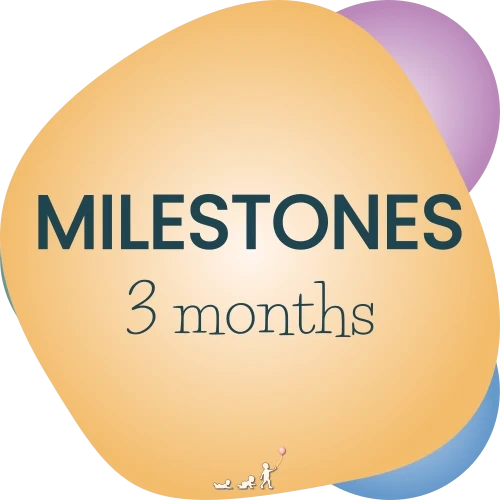
Inspiration for activities in month 3
- Talk to your baby a lot. If you’re not sure what to say, just say what you’re doing. For example, “Now you need a dry diaper, so I’m going to take off your onesie.”
- Lay your baby on an activity mat and place a toy so that it dangles at tummy or crotch level so that baby has to look down a little (instead of straight up).
- Place your baby on their side supporting their back so they don’t tilt and play with toys in this position. Remember to change sides.
- Gently turn your baby upside down every day. Spin around with your baby in your arms and rock your baby back and forth and to the side.
- Pick your baby up sideways instead of straight up.
- Carry your baby on your arm at an angle to the side rather than vertically to engage your baby’s core muscles.
Consult your healthcare provider if your baby in month 3
- Has a beginning flat or asymmetrical back of the head. The best way to check this is to look at the top of your baby’s head. Confirm the symmetrical position of the ears. The back of the head should be round and symmetrical. If this isn’t the case, it’s important to get help as soon as possible.
- Has limited freedom of movement in the neck. Ideally, your baby should be able to align their chin to both shoulders when looking sideways.
- Arches their body backwards or bends their body in a C/banana shape consistently to either side.
- Seems inconsolable a lot of the time.
- Doesn’t like lying on their tummy.
- Raises their thighs off the floor lying on their tummy.
- Doesn’t lift their legs while lying on their back.
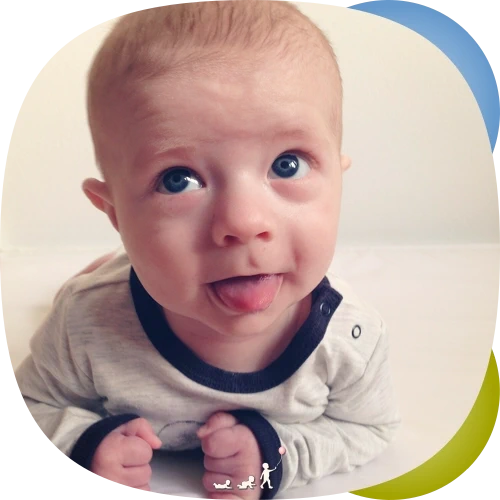
Baby milestones in month 4
In month 4, your baby
- Lifts their legs while lying on their back.
- Is able to bring their toes to their nose (if assisted) while lying on their back.
- Uses smiles and babbling to make and maintain eye contact.
- Has small “chit-chat” conversations.
- Sees colors and see across the room, but still prefers things up close.
- Grasps and releases toys more confidently. Also likes to shake a rattle to make sounds.
Tip: Anything that fits in a toilet roll is too small to put within your baby’s reach! - Holds their head firmly while lying on their tummy and bring their forearms forward in front of the body and push up onto their elbows.
- Starts to practice rolling sideways (from back to tummy).
- Notices the difference between different textures.
- Understands cause and effect at a basic level. For example, “If I drop the toy, Mommy/Daddy will pick it up”.
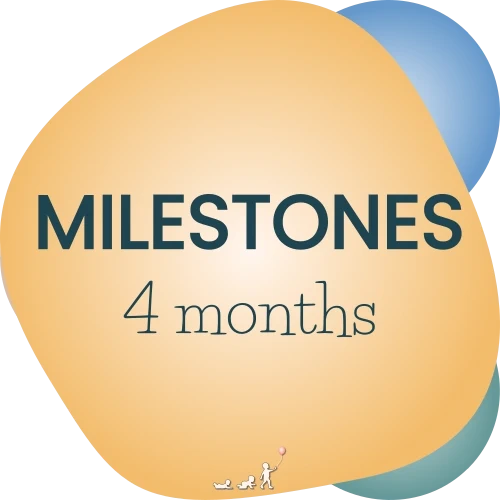
Inspiration for activities in month 4
- Practice rolling around (from back to tummy) and feel free to help your baby by gently pushing a little at a time. Help as little as possible and wait for a muscle contraction.
- Offer touch-and-feel books.
- Start drawing your baby’s attention to the sides while your baby is lying on their tummy. If necessary, put yourself behind your baby for this. The aim is to get your baby to look backwards and then later to turn/pivot around.
- Practice leg lifting while lying on their back, for example on the changing table.
- Do tumbling exercises. For example, put on some good music and dance around with your baby on your arm.
Consult your healthcare provider if your baby in month 4
- Doesn’t use facial expressions or doesn’t babble.
- Bends their body in a C/banana shape consistently to either side.
- Arches their body backwards.
- Lifts their arms and legs while lying on their tummy, and is unable to bring them back down.
- Unable to lift their legs in while lying on their back.
- Doesn’t like lying on their tummy.
- Tilts their head constantly to either side while sitting up or lying down.
- Has a flat or asymmetrical back of the head.
- Shows motor restlessness resulting in too little sleep and too poor quality sleep.
👉 check out exercise program DeveloBaby Sleep
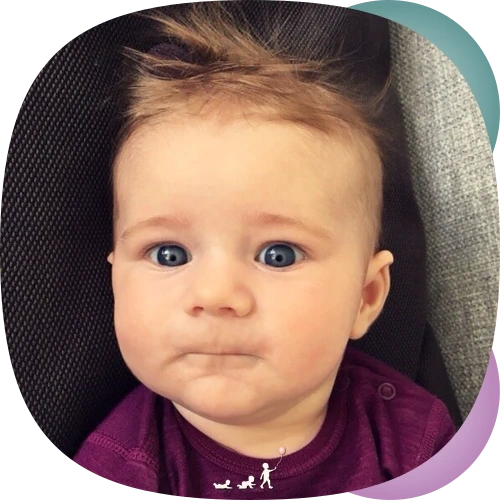
Baby milestones in month 5
In month 5, your baby
- Can see even small objects and all colors. Can follow objects with their eyes and turn their head all the way to the chin-over-shoulder position on both sides. Both hearing and vision are now almost fully developed.
- Can pass an object from one hand to the other.
- Recognizes their name and respond.
- Rolls from back to tummy.
- Grabs their thighs while lying on their back.
- Extends their arms briefly while lying on their tummy, for example, when you dangle a toy over their head.
- Starts to feel a little uncomfortable around unfamiliar adults and “checks them out”.
- Communicates emotions such as happiness, anger, sadness and fear. Shows a variety of facial expressions and laughs.
- Reaches for toys while lying on their tummy and stretches their body to grasp them.
- Wants to put everything in their mouth.
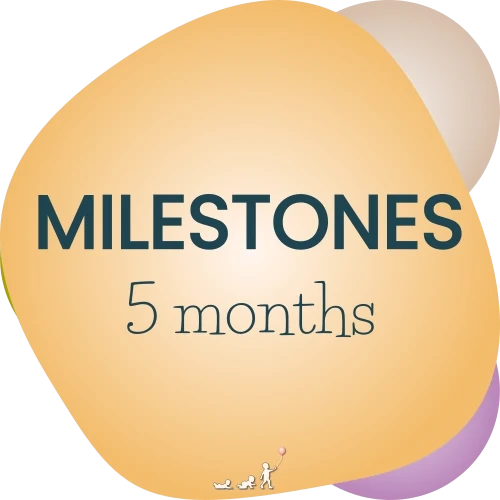
Inspiration for activities in month 5
- Practice rolling from back to tummy – preferably on a soft surface.
- Baby swing / sensory swing, hammock, upside-down (vestibular sense).
- Dance with your baby.
- Baby swimming.
- Pressure massage.
Consult your healthcare provider if your baby in month 5
- Doesn’t use facial expressions or doesn’t babble.
- Doesn’t show signs of wanting to roll from back to tummy.
- Has a hard time holding their head up while lying on their tummy or sitting with you.
- Doesn’t like lying on their tummy.
- Acts passive and doesn’t explore things curiously.
- Tilts their head constantly to either side while sitting up or lying down.
- Has a flat or asymmetrical back of the head.
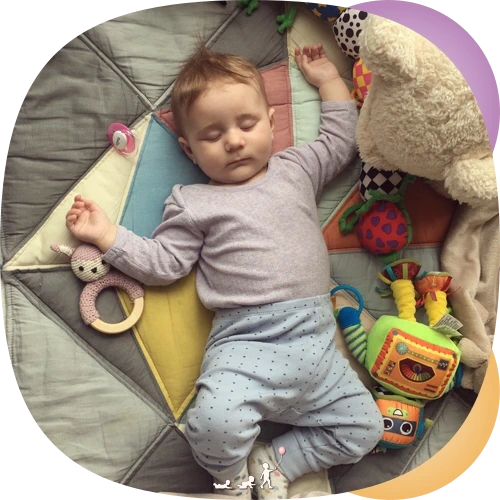
Baby milestones in month 6
In month 6, your baby
- Enjoys playing with others, especially parents.
- Can safely pass an object from one hand to the other.
- Responds to and mirrors the emotions of others. Is usually happy.
- Rolls from back to tummy equally effectively in both directions.
- Turns (pivots) around their own axis in both directions.
- Extends their arms while lying on their tummy and supports the weight of their upper body on their elbows / hands.
- Shows curiosity about objects and tries to reach things that are out of reach.
- Starts putting vowels together and makes specific sounds for happy and sad emotions.
- Grabs their feet while lying on your back.
- Will still want to put everything in their mouth.
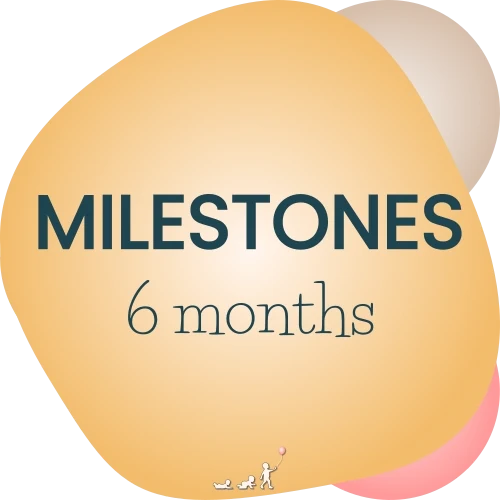
Inspiration for activities in month 6
- Roll and turn (pivot) on the floor. Get comfortable to be on the floor with your baby, because that’s where it’s good to be.
- Play lying on either side.
- Practise stretching their arms while lying on their tummy by drawing your baby’s gaze upwards.
- Offer different consistencies and textures for baby to touch and taste to develop their senses.
- Sing with your baby.
Consult your healthcare provider if your baby in month 6
- Doesn’t roll, or rolls only in one direction.
- Doesn’t lift their legs while lying on their back.
- Doesn’t laugh.
- Acts passive and doesn’t explore things curiously.
- Tilts their head constantly to either side while sitting up or lying down.
- Is rigid and tight in their body.
- Is soft and floppy with little body tension.
- Has a flat or asymmetrical back of the head.
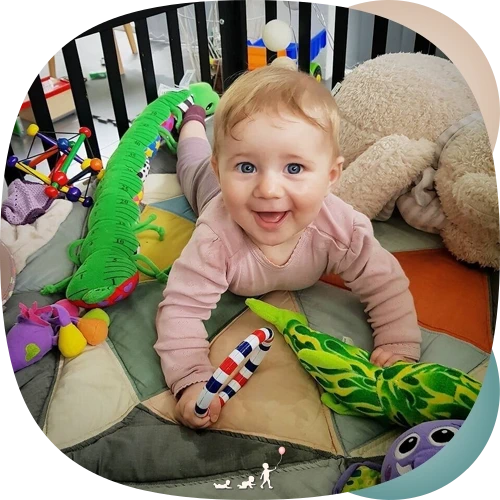
Remember to also pay attention to YOURSELF!
It’s important to get help if you feel overwhelmed and sad. Becoming a parent is hard – even if your baby is entirely average. Your babies may sleep very little and /or demand most of your time. It is quite common for parents to become overwhelmed by the new family life style. Talk to your partner and consider to seek advice from your health care providers. ❤
Baby milestones in month 7
In month 7, your baby can
- Rolls from back to tummy and back and in both directions. However, you probably won’t see them roll from tummy to back as often, as your baby will be less inclined to lie on their back.
- Moves around on the floor, pivots (turns) and rolls around for toys and practices crawling forward.
- Lifts their bottom while lying on their tummy.
- Can stand on all fours (hands and knees).
- Uses fingers to grasp objects and can now actively release.
- Drops objects on the floor/table and enjoys the sound it produces.
- Begins to experience separation anxiety (7-10 months).
- Begins to understand language as a concept and understands when you say “No”.
- Begins to understand object permanence, which means that your baby now knows that you’re not really gone when you play peekaboo, or that toys still exist even when they’re out of sight.
- Begins to sound more like speech in their babbling by going up and down in pitch.
- Begins to sit unsupported in the high chair at mealtimes.
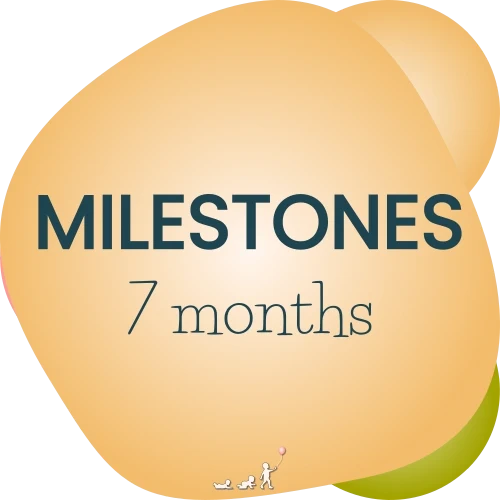
Inspiration for activities in month 7
- Allow your baby to play and fuss with the food.
- Peekaboo is still great! (object permanence).
- Practice rolling, back to tummy and back both directions.
- Practice turning (pivoting).
- Practice commando crawl: lay your baby on their tummy, bend one knee and hold the foot firmly on the floor until your baby pushes forward by straightens that knee)
- Tumbling.
Consult your healthcare provider if your baby in month 7
- Cannot maintain eye contact.
- Doesn’t roll or only rolls in one direction.
- Acts passive and doesn’t explore things curiously.
- Clenches their hands or maintains a thumb-in-fist position.
- Uses only one hand or shows clear preference in the use of hands.
- Begins to show signs of an asymmetrical commando crawl.
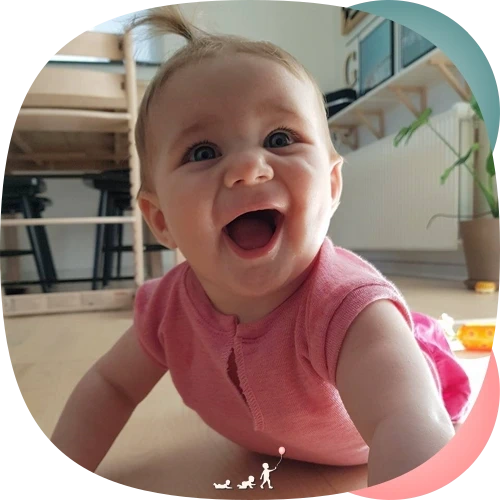
Baby milestones in month 8
In month 8, your baby
- Crawls around on the floor using both arms and legs equally and alternately.
- Gets on all fours with a nice cross crawl (either this month or next).
- Begins to practice and perhaps masters sitting up even from a lying position.
- Crawls over small obstacles such as your legs.
- Has separation anxiety (7-10 months) and will often express periods of having a favorite person (e.g. mom or dad).
- Begins to understand body language. For example, if you point at something, they will look for it.
- Makes sounds to get your attention and imitates your sounds.
- Explores things with curiosity.
- Puts food in their mouth with their hands and moves food around in their mouth using their tongue.
- Rolls from tummy to back. However, some babies hardly ever do this as they no longer want to lie on their back. That’s okay!
- Begins to sit unsupported. Avoid putting your baby on the floor in a sitting position, though, but rather lay them down and let them sit up on their own.
- Rocks back and forth in a crawling position.
- Tries pulling themselves up to stand up next to you holding on to you or furniture.
- Can carry their weight on their legs.
- Has an almost fully developed vision, and can thus be tempted by objects across the room.
- Recognizes faces.
- Responds to their name.
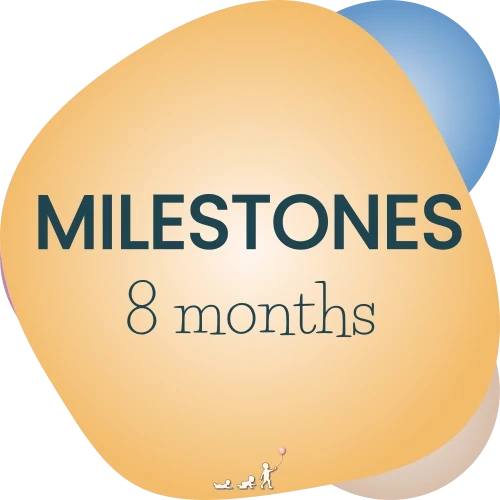
Inspiration for activities in month 8
- Read to your baby – use your words.
- Miles and miles of commando crawling and crawling.
- Play music and dance.
- Play hide and seek with object/toys.
- Tumbling.
Consult your healthcare provider if your baby in month 8
- Cannot maintain eye contact.
- Doesn’t reach for objects or shows no interest in moving around.
- Acts passive and doesn’t explore things curiously.
- Uses an asymmetrical commando crawl (has had a preferred side previously) or doesn’t crawl, at all yet.
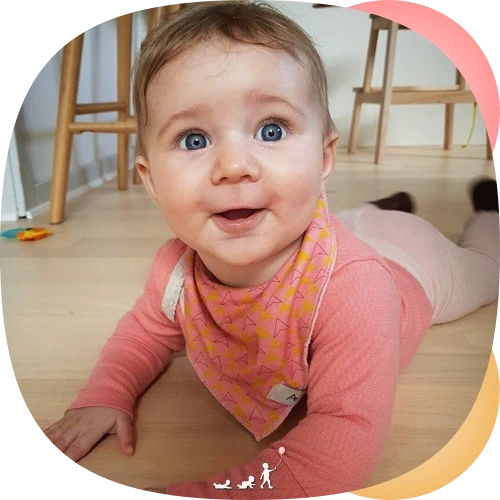
Baby milestones in month 9
In month 9, your baby
- Crawls on both knees and both hands with crossing movements.
- Independently rolls from back to tummy and gets up in crawling position (and back again).
- Begins to practice crawling up steps/stairs.
- Pulls themselves up into a standing position. The ankles may still be soft and pointing inward, and your baby may still be standing on their toes, which is fine as long as they can get their heel on the ground.
- Masters the tweezer grip and can pick up small objects.
- Begins to play with the putty box and will generally explore how things fit together.
- Investigates things with curiosity and eagerness. Childproofing the home becomes necessary as your baby will now be everywhere.
- Babbles nonstop, almost as if they are saying nonsense sentences.
- Begins to understand what you say. For example, the word “No” will make your baby stop.
- Can sit unsupported and getting there on their own.
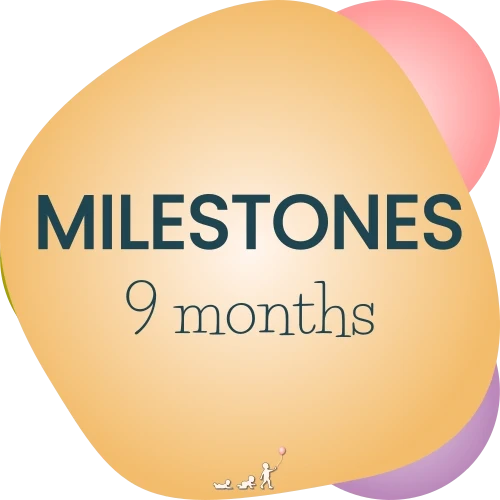
Inspiration for activities in month 9
- Talk to your child a lot. Say out loud what you are doing and what your baby is doing. Try asking small questions like “Where is the ball?”. Baby will practice understanding these things. Don’t be afraid to repeat yourself 50 times. Repetition is key. You will get bored long before your baby does.
- Miles and miles of crawling! Crawling builds many skills.
- Play music and dance. Exercice the balance sense, upside-down and spin around. Laugh together!
- Practice their tweezer grip for example with small pieces of soft fruit.
- Encourage your baby to be active. Get comfortable on the floor with your baby to make it a pleasant situation for everyone.
Consult your healthcare provider if your baby in month 9
- Doesn’t crawl, yet.
- Doesn’t like to play while lying on their tummy.
- Crawls asymmetrically and has had a preferred side previously.
- “Bottom scoot crawls” with hands and bottom on the floor (instead of hands and knees)
- “Crab crawls” with one foot, one knee and hands on the floor (instead of hands and knees)
- “Bear crawls” with hands and feet/balls on the floor (instead of hands and knees).
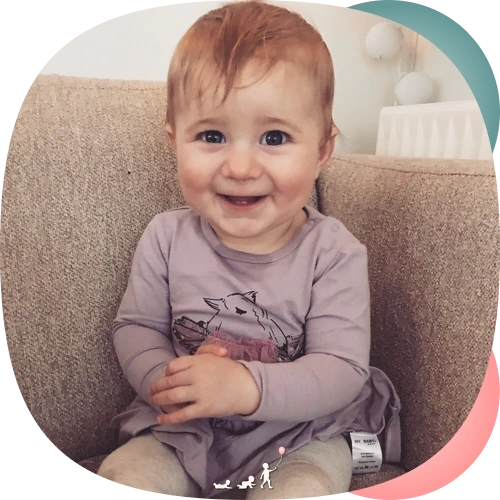
Baby milestones in month 10
In month 10, your baby
- Stands up and stands steady, but may still hold on. Tip: remove the seat cushions from your sofa to get a good height for standing and walking along.
- Gradually practices walking sideways. Still holds on well and still has soft ankles. The muscles in the ankles are being challenged for the first time in development and it will take time for the ankles to be fully stabilized.
- Gets back down from standing to crawling position on their own (or practices it).
- Moves easily from lying on tummy to seated position.
- Points at things, claps and waves (if practiced).
- Understands small sentences. For example, “Can you wave?”
- Picks up finger food and eats it.
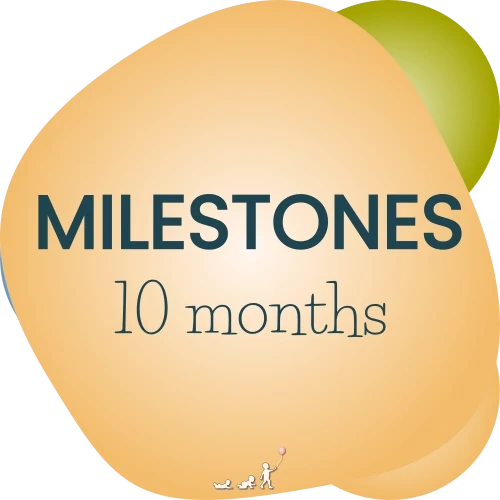
Inspiration for activities in month 10
- Sing and tumble with your baby.
- Peekaboo is still great! (object permanence).
- Commando crawl or crawl over obstacles (e.g. your legs or mattresses).
- Practice sideways walking around a sofa table by putting objects/toys on the opposite side of the table, when you baby is at the table.
- Miles and miles of crawling.
Consult your healthcare provider if your baby in month 10
- Doesn’t crawl and doesn’t commando crawl.
- Crawls asymmetrically.
- “Bottom scoot crawls” with hands and bottom on the floor (instead of hands and knees)
- “Crab crawls” with one foot, one knee and hands on the floor (instead of hands and knees)
- “Bear crawls” with hands and feet/balls on the floor (instead of hands and knees).
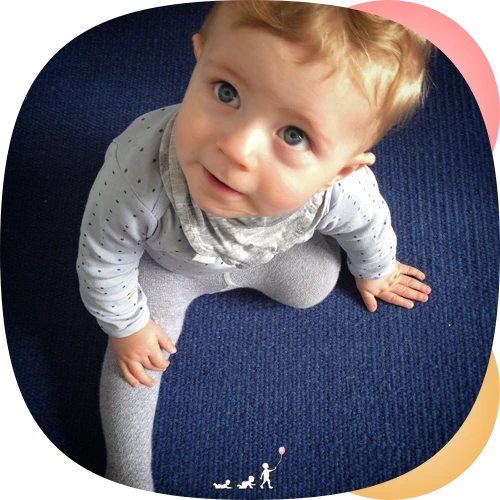
Baby milestones in month 11
In month 11, your baby
- Stands up and sits down again, holding on to furniture.
- Walks sideways around furniture.
- Claps, waves and raises his/her arms to signal that they want to be picked up.
- Crawls, which is still the primary mode of transportation.
- Practices standing freely for short periods of time.
- Sometimes says a few understandable words. Maybe “yes” or “no”?
- Shows great curiosity and explores everything.
- Climbs on and over things. For example, on stairs, across the playpen or crib, or up on small low furniture.
- Can sit with a spoon and put food in their mouth, but prefers to use their fingers.
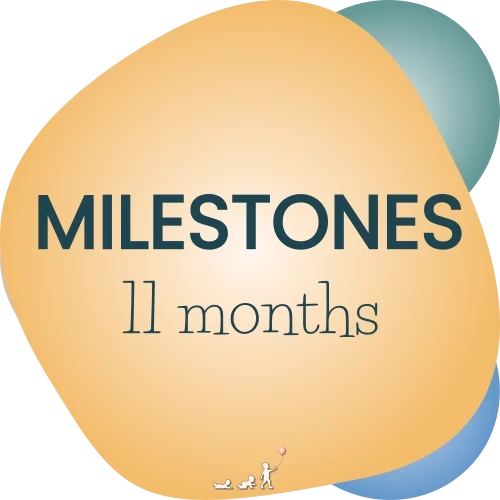
Inspiration for activities in month 11
- Putty box.
- Peekaboo.
- Stacking toys.
- Dance to music.
- Miles and miles of crawling and sideways walking.
- “What does the animal say?” game.
- Tumbling, upside-down and spin around and lots of touching.
Consult your healthcare provider if your baby in month 11
- Cannot maintain eye contact.
- Doesn’t crawl.
- “Bottom scoot crawls” with hands and bottom on the floor (instead of hands and knees)
- “Crab crawls” with one foot, one knee and hands on the floor (instead of hands and knees)
- “Bear crawls” with hands and feet/balls on the floor (instead of hands and knees).
- Does not show initiative or curiosity.
- Cannot sit independently.
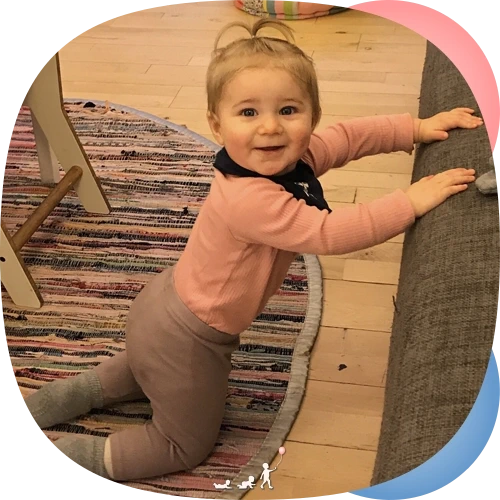
Baby milestones in month 12
In month 12, your baby
- Gets up and walks around furniture.
- Stands freely, usually only briefly.
- Crawls up stairs.
- Sits steadily on the floor and in a high chair.
- Eats independently using hands (tweezer grip) and spoon.
- Sits down on the floor from standing without assistance.
- Follows quick movements with their eyes.
- Responds to their name.
- Understands object permanence (that something still exists even when it’s out of sight).
- Connects words and objects to understand many things you say.
- Practices independence by exploring familiar places without you.
- Note: you don’t need to practice walking with your baby and a baby walker is not necessary. A long crawling phase builds a strong gait.
- Many babies start walking this month. But as long as your baby is crawling and active, don’t worry if your baby isn’t walking yet. They will!
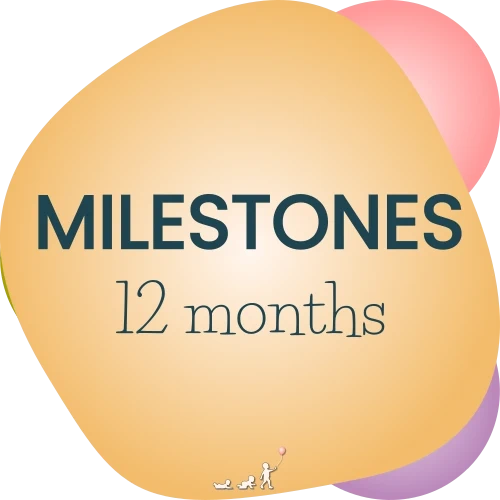
Inspiration for activities in month 12
- Play “pretend”. For example, talk on the toy phone or feed the teddy bear.
- Putty box
- Read picture books. Talk about what you see.
- Roll a ball back and forth between you and your baby.
- Peekaboo.
- Hammerbench, Whack a Mole or similar.
- Miles and miles of crawling will strengthen your child’s gait, so crawl, crawl, crawl, crawl!
- Sideways walk around furniture.
- For example, place dining chairs around the living room with toys on them to encourage crawl → get up → sit down → crawl.
Consult your healthcare provider if your baby in month 12
- Doesn’t crawl.
- Crawls asymmetrically.
- “Bottom scoot crawls” with hands and bottom on the floor (instead of hands and knees)
- “Crab crawls” with one foot, one knee and hands on the floor (instead of hands and knees)
- “Bear crawls” with hands and feet/balls on the floor (instead of hands and knees).
- Does not show initiative or curiosity.
- Doesn’t babble or doesn’t show facial expressions.
- Is unable to use tweezer grip or uses only one arm.
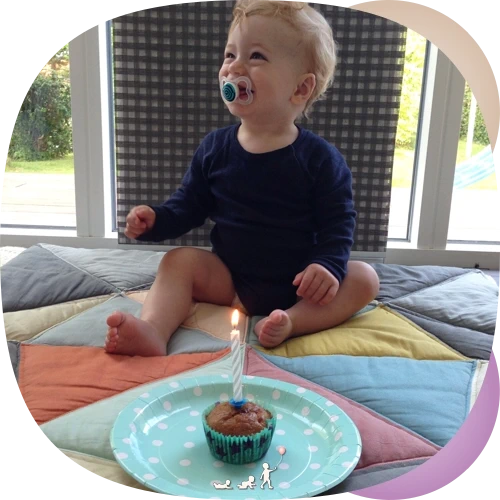
Remember the “normal distribution.” And remember that “normal” and “average” are broad terms!
References
- Motor Skills, Pathways.org
- Motor Assessment of the Developing Infant, M.C. Piper & J. Darrah, 2021, Elsevier
Disclaimer
All content on DeveloBaby.com is based on recognized professional standards in Denmark, and you can expect them to be in line with the advice you receive in the public health system. If you find that your child has pronounced sleep or motor challenges, or that there is a lack of effect from the general exercises, I recommend that you make an appointment with me, either in person or online, so that I can customize the program for your child. If your child is unwell, please always contact your health care provider or physician. Read full disclaimer…
